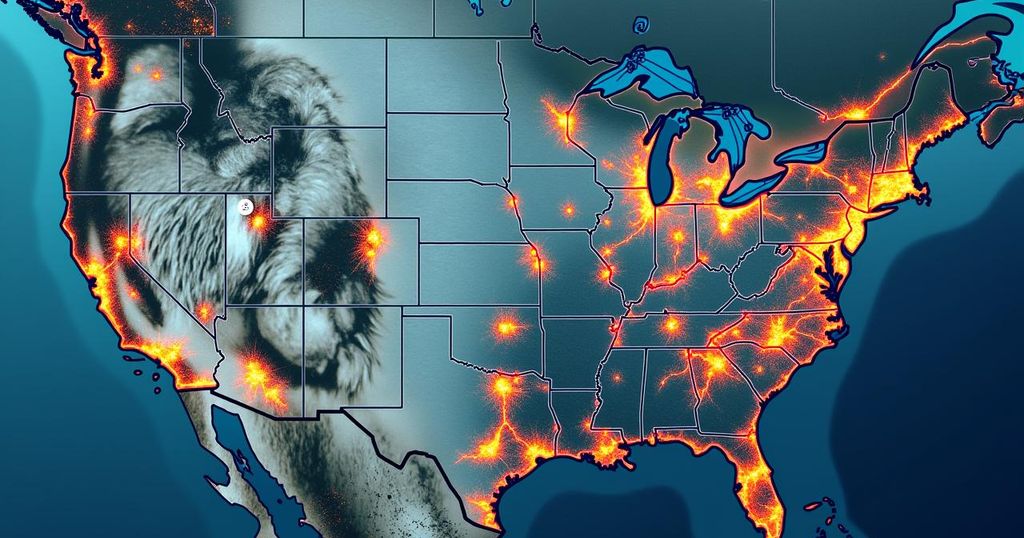Following the destruction wrought by Hurricane Helene, the National Hurricane Center is monitoring three tropical storm systems—Isaac, Joyce, and Kirk—with none expected to make landfall in the U.S. Helene caused over 100 fatalities and significant damage across several states. Spaghetti models suggest these storms might head toward Europe or dissipate, while two additional disturbances are being observed, with potential implications for the Gulf Coast.
The National Hurricane Center (NHC) is currently tracking three tropical storm systems—Isaac, Joyce, and Kirk—following the devastating impact of Hurricane Helene. Helene, a Category 4 hurricane, made landfall last Thursday night with maximum sustained winds reaching 140 mph in the Big Bend region of Florida. The storm led to significant destruction and loss of life across various Southern and Southeastern states, resulting in over 100 fatalities according to the Associated Press. In the aftermath of Helene, the Atlantic hurricane season has intensified with the emergence of the three named storms. Post-tropical cyclone Isaac is located far out at sea, northeast of the U.S., with maximum sustained winds of 60 mph. Tropical Depression Joyce is situated southeast of the U.S., exhibiting maximum sustained winds of 35 mph. Meanwhile, Tropical Storm Kirk, positioned southeast of Joyce, has maximum sustained winds of 50 mph. Spaghetti models, which are computer-generated projections of potential storm paths, indicate that none of these systems are likely to make landfall in the United States. Most trajectories suggest that Isaac will veer toward Europe, although it is expected to weaken further prior to reaching any land. Joyce is projected to dissipate by Monday. Kirk may maneuver northeast, targeting Europe, although one model indicates it could take a more unusual southwestern route toward Guyana in South America. National Weather Service Warning Coordination Meteorologist Will Ulrich informed Newsweek that while it is improbable for these storms to directly affect the United States, Kirk could create indirect hazards such as rip currents along the Eastern Seaboard, with warnings likely to be issued for areas impacted by these currents. The NHC is also observing two potential disturbances, one of which may pose a risk to the U.S. Gulf Coast if it continues to develop. Disturbance 1 is characterized as a large, disorganized area of low pressure over the western Caribbean Sea, generating some thunderstorms, yet is deemed unlikely to evolve into a named storm within the next 48 hours. The NHC estimates that there is a 40 percent chance of the system developing over the next week. Experts noted, “While interests in the northwestern Caribbean Sea and along the U.S. Gulf Coast should continue to monitor the progress of this system, the timetable for potential development has shifted later toward late week or this weekend.” AccuWeather’s lead hurricane expert Alex DaSilva remarked that although Disturbance 1 could still develop into a tropical system, the energy appears less concentrated than previously observed, diminishing the likelihood of it becoming a significant hurricane. Disturbance 2, located a few hundred miles south of the Cabo Verde Islands, carries a 30 percent chance of formation within 48 hours and an 80 percent chance over the next week, as upper-level winds are forecasted to favor gradual development. Spaghetti models for these newer disturbances have yet to be generated, reflecting their nascent stages.
The Atlantic hurricane season consists of periods when tropical storms and hurricanes typically develop in the Atlantic Ocean, often impacting landmasses, particularly in the U.S. The monitoring and forecasting of these storms are carried out by the National Hurricane Center, which utilizes advanced meteorological tools and methodologies, such as spaghetti models, to predict the paths and potential impacts of these storm systems. The progression of the current storm systems follows the catastrophic impact of Hurricane Helene, emphasizing the volatility of weather patterns during the hurricane season and highlighting the needs for community preparedness.
In summary, the National Hurricane Center continues to monitor three active tropical storm systems—Isaac, Joyce, and Kirk—subsequent to the destructive passage of Hurricane Helene. While projections indicate that these systems are unlikely to make direct landfall in the U.S., there still exists the potential for secondary impacts. Additionally, NHC is closely examining two disturbances that may pose future risks to the Gulf Coast. Accurate tracking and timely alerts will be crucial as the hurricane season progresses.
Original Source: www.newsweek.com






